I'm using this link to search for particular energies in which gammas may be emitted (for nuclide identification on a gamma spectrum).
If on the above link you go down to the "γ condition #1" line, and put the energy between 2241 an 2243, and click search, you get the list of Nuclides which emit gammas between these energies. The second in the list (24Mg), in the half life column, has a halflife given in keV.
This isn't the only time this occurs, this is just one example. To my mind there's no way that you can have a half-life given in keV.
Can you, in fact, give a half life in keV (or any unit of energy)? How would that make sense?

